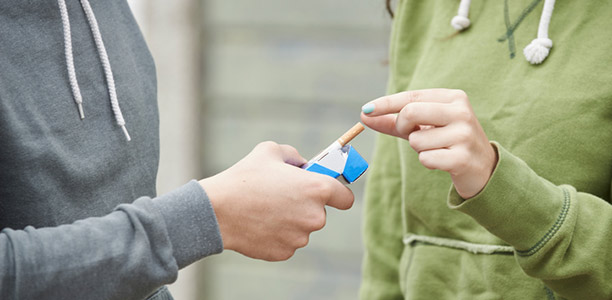The way things stand now, tobacco use will kill one billion people in the 21st century. In the United States, 90% of smokers pick up the habit by age 18, making adolescence a critical time for smoking prevention efforts.
Peer influence has long been known as a major risk factor for adolescent smoking, but findings have varied about how big the risk is, or how this dynamic unfolds. A new, rigorous meta-analysis of 75 longitudinal teen smoking studies published in the journal Psychological Bulletin finds that having friends who smoke doubles the risk that children ages 10-19 will start smoking and continue smoking. It also found that peer influence is more powerful in collectivist cultures than in those where individualism is the norm.
There has been a great deal of research about peer influences on adolescents, says the study’s senior author, Dolores Albarracín Ph.D., Professor of Psychology at the University of Illinois at Urbana-Champaign, but often findings rely on individual studies. “Meta-analysis is a summary of all we know,” she says, “giving us a more reliable, robust number that is better supported by the facts.”
“One of our most intriguing findings is that culture actually matters in how much influence adolescents have on their peers,” says the study’s lead author, Jiaying Liu, Ph.D., a recent graduate of the Annenberg School for Communication at the University of Pennsylvania. “Meta-analysis allowed us to examine studies from across the globe. We predicted that people in collectivistic cultures would be more likely to be influenced by peers around them, and that held true. In those most collectivistic countries, adolescents whose peers smoke are 4.3 times more likely to pick up smoking compared to people who have no peers smoking. By contrast, having peers who smoke made adolescents from those most individualist countries 1.89 times more likely to smoke.”
The study included data from 16 countries, both collectivistic — for example, China, South Korea, Jordan, and Portugal — and individualistic ones like the United States, Australia, Canada, the Netherlands, and the United Kingdom.
The authors also examined the ethnic origins of the adolescents in each study, regardless of nationality. “We found that peer influence was much weaker in samples with higher proportions of adolescents with a European background, but much stronger in samples with higher proportions of adolescents with an Asian background,” says Liu.
This finding about ethnic and cultural background may also explain why the results of teen smoking studies have varied in how big an effect peer influence has.
In addition, the study found that closer friends were more likely to influence peers to start smoking when compared to more distant friends. The closeness of peer friendships did not impact whether adolescents who smoke continued to smoke, however, indicating that perhaps the addictive nature of tobacco was an overriding factor.
The study was also able to better avoid what is often seen as the “chicken or the egg” problem of peer influence smoking studies: Do teens influence one another to smoke, or do those who smoke simply tend to become friends?
“By including only longitudinal studies, where peer influence was measured at an earlier time and adolescent smoking outcomes at a later date, we were better able to establish that peer influence led to the adolescent smoking outcomes, rather than the other way around,” says Liu, who will be starting in the fall as an assistant professor at the University of Georgia’s Department of Communication Studies.
The researchers hope that by providing a better understanding of the risk factors for teen smoking, they can help inform more targeted prevention efforts. By knowing who is most at risk, parents and public health officials alike can give teenagers the tools to resist tobacco.
“It’s not enough just to say, ‘Don’t smoke it’s bad for you,’” says Albarracín. “How are teenagers going to deal with temptation on a daily basis? We need much more specific campaigns dealing with normative influence — for example, pointing out how many adolescents don’t smoke. There can be more messaging in schools, and training for parents on how to build refusal skills in their children.”
Peer influence is particularly strong in the adolescent years, as children reduce the amount of time spent with parents and increase the amount of unsupervised time spent with peers.
“This work highlights the importance of considering the networks that surround teens, not just thinking about individuals in isolation,” says co-author Emily Falk, Ph.D., associate professor at the Annenberg School for Communication at the University of Pennsylvania and director of its Communication Neuroscience Lab. “Behaviours spread from person to person and keeping that in mind is essential for prevention and cure.”
“The burden of smoking-caused morbidity is heavy around the world,” says Liu. “If social influence is a crucial factor in adolescents’ decision to start smoking and keep smoking, we want to understand how to leverage its power for better smoking prevention. It’s always easier to stop people from starting to smoke than to change their behaviour later in life.”
(Source: Annenberg School for Communication – University of Pennsylvania, Psychological Bulletin)










